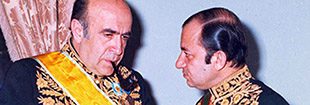After graduating from the Isfahan School of Fine Arts, Farshchian sought to broaden his horizons. In the mid-20th century, many Iranian artists looked to Europe, particularly Paris, Rome, and Florence, for exposure to Western artistic movements. Farshchian traveled to Europe and enrolled at the Conservatory of Fine Arts, where he immersed himself in academic study while also spending countless hours in the continent’s great museums.
Farshchian often recalled how he would arrive at a museum with a bundle of books and a pen, becoming the first visitor to enter and the last to leave. This dedication allowed him to study masterpieces from different eras—Renaissance paintings, Baroque compositions, and Impressionist color theories. Yet, unlike some contemporaries who fully embraced Western styles, Farshchian absorbed these influences selectively, integrating elements of perspective, anatomy, and light into his Persian miniature foundations without abandoning his cultural roots.

